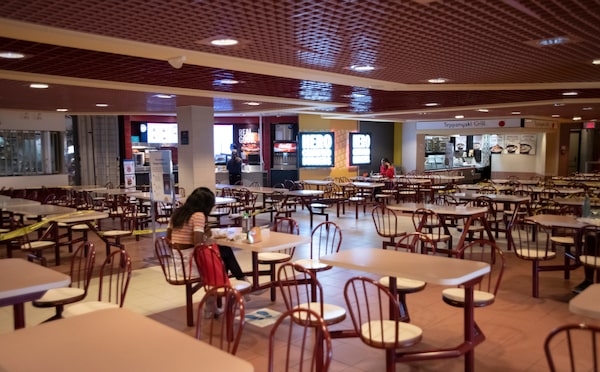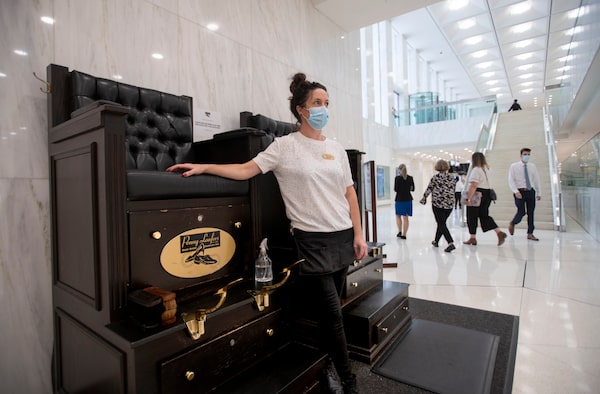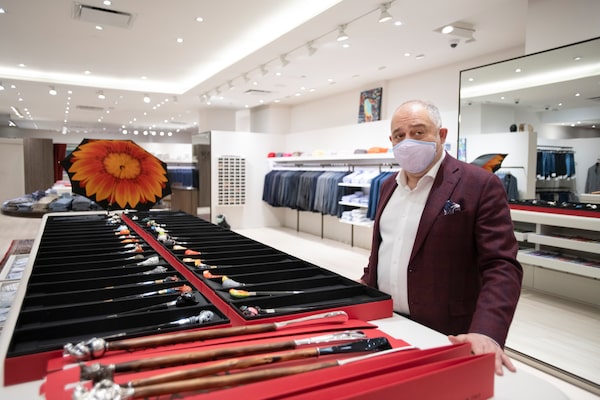
The PATH underground system under the Sheraton Centre on Oct 13.Fred Lum/The Globe and Mail
There are more staff than shoppers in many parts of the mall that lies under Toronto’s financial district, more people cleaning the corridors than walking along them.
While some Bay Street companies have started allowing small numbers of employees to return to their office buildings, workers are going in sporadically, if at all. As the pandemic drags on, the question of when – or whether – the area will regain its pre-COVID hubbub is casting a darkening pall over the more than 30-kilometre-long network of retail tunnels beneath the city centre.
Downtowns around the world are agonizing over how to preserve their appeal as COVID-19 recedes. The sprawling underground mall in downtown Toronto – dubbed the PATH – is a microcosm of that concern, a zone so tied to the economic fortunes of the buildings above it that it risks becoming a place without a compelling reason to exist.
How Calgary copes with a record amount of office space sitting empty
Opinion: In the move to remote work, we are losing our sense of connection to the workplace
The PATH was once highly desirable retail space, with merchants and restaurateurs accustomed to hordes of foot traffic appearing reliably every weekday. But the rationale for paying premium rents becomes harder to justify if the office towers don’t fill again. Or if, as the pattern seems to be emerging, they fill only partly as companies permanently embrace a part-home-part-office hybrid model.
At Teppanyaki Grill, in the PATH, restaurant owner Ernest Huang used to serve a steady stream of office workers and have lineups snaking around the perimeter of his stall. Now, to survive, he has slashed hours by more than half and taken another job to make ends meet.
“It’s very slow,” he said. “My customers are telling me that they are only working one to two days a week.”
Most banks, insurers and other Bay Street firms have delayed a large-scale return to the office until at least next year. Major office tenants such as Sun Life Financial Inc. and PwC Canada have told employees they can choose when to come into the office. Royal Bank of Canada, National Bank and other banks have embraced some version of a hybrid work arrangement.
With the office model evolving, the volume of office workers and foot traffic may never return to prepandemic days.
According to information provided to the consulting firm Strategic Regional Research Alliance by building managers and tenants, the volume of people in downtown Toronto offices has quadrupled from its pandemic low – but was still only 12 per cent of normal at the beginning of October. Recent transit data show that the number of GO train and TTC passengers being counted at Union Station, a key transportation hub on the PATH, was only 16 per cent and 30 per cent of prepandemic norms, respectively.
Avison Young, a commercial real estate services firm, is tracking foot traffic in the downtown core, using anonymized cellphone pings. As of last week, foot traffic was down 86 per cent compared to prepandemic levels.
Hundreds of PATH retailers have been devastated by the work-from-home mandates and the emptying of Toronto’s financial district. Corridors are dotted with spaces that are either closed or papered over.
Instead of streams of transit riders and office workers passing daily by the 3.7-million-square feet of retail space in the PATH, which the city says generated $1.7-billion in annual sales before the pandemic, there is only a trickle. It’s possible at times to stand in the tunnels and see no one else.
University of Toronto associate professor of architecture Laura Miller said the PATH may need to reinvent itself for a permanently changed future.
“The PATH is on pause and so it’s a moment to capitalize on and not just hope that we return to normal because I think that’s nostalgic,” she said. “It’s nostalgic and also delusional.”
Prof. Miller, who has taught a course on the PATH and is writing a book on it, drew a parallel with above-ground malls that had to reinvent themselves by leasing space to call centres or other non-traditional tenants.
In the case of the tunnels under downtown Toronto, she suggested that the network needs to be integrated better with the downtown residential community. She questions whether a growing number of people living downtown might cause new services to set up in the tunnels to cater to them. And she wonders if, should rents drop, that would encourage a less homogenous retail mix that helps draw in more than the usual convenience shoppers.
Nineteen months into the pandemic, those convenience shoppers are still in short supply. Signs of recovery in this area remain elusive. White-collar workers were among the first to embrace working from home and many of the companies in these towers have been slow to bring back their employees.
Still, some are expressing cautious optimism that the worst may be over.

Jenny Young, a part time shoe shiner with the Penny Loafers Shoe Shine Company, in the stand at First Canadian Place on Oct 13.Fred Lum/The Globe and Mail
At Penny Loafers, a venerable trio of shoeshine kiosks in the PATH that has outlived other crises facing downtowns, including the 9/11 attack on New York and the SARS outbreak, staff last week were cleaning the chairs and relaunching in earnest for the first time since early 2020.
Standing by a pair of tall chairs under First Canadian Place, supervisor Jenny Young said that this seemed a good time to test the waters. Fall is traditionally one of their busier periods of the year, as social outings increase and people switch from warm-weather to more formal footwear. The company is planning to experiment with its operating hours and staffing levels to find out what works best.
“We’re not going to be able to operate at full capacity for a while,” Ms. Young said, noting that the schedule for a return to something approaching normalcy is hard to predict. “Maybe January. Maybe. Or a year from now.”
Early results were mixed. One attendant had seven clients the first day while another went home without making any money, company owner Penny Simmons said later.
Because the PATH is such a specialized space, many landlords do not allow retailers to put their space up for sublet and prefer to take the space back, according to leasing brokers. Struggling retailers have either had to close permanently, use publicly funded rent relief or renegotiate the terms of their leases with their landlords.
For example, at one of Mean Bao’s locations in the PATH, the Chinese steamed bun eatery negotiated a rent deal when traffic slowed considerably. Rent at one temporary location, which is currently closed, is based on the percentage of its sales instead of the standard fixed amount each month. It pays full rent at the other location, according to its co-owner Scott Ching.
Stan Krawitz, who works with dozens of PATH retailers as vice-chairman of Savills Canada, a commercial real estate firm, said he has been in constant talks with landlords. He said current solutions to help tenants weather the pandemic are not intended to be long-term fixes.
“All of these negotiations are a temporary fix and none of these are long term and all of them are on the basis of what the current situation is. As soon as it changes, the landlord has the right to revise the deal,” he said.
Ali Fieder, Avison Young’s vice-president of retail, said in some cases landlords are offering incentives for tenants to stay. She said many retailers are hoping to tie their reopening dates to when they know office occupancy is back to a reasonable threshold.
At the menswear store Vassi, in First Canadian Place, the outlook is dire. Owner Andre Vassi said there are practically no customers and predicts he will have to close next year if sales don’t pick up. By midafternoon one weekday, a reporter was the only person to have set foot in his store that day.
“We are all dependent on the towers above us and basically the towers are empty,” he said. “This is not regular retail.”
Just before the pandemic started, he tripled the size of his retail space because demand for his designs was growing. His top-selling item used to be a sport jacket; today it is a shoehorn.
Farther south in the tunnel network, under Royal Bank Plaza, the manager of an outlet of the fancy tea purveyor T. Kettle was so short of customers one weekday he had a hefty hardcover book laid out on the counter. You can only clean and tidy and organize stock so much before you need something to pass the time, explained Stephen Bent, who was ploughing through the nearly 700-page fantasy bestseller A Conjuring of Light.

Andre Vassi, owner of Vassi, a menswear shop in First Canadian Place.Fred Lum/The Globe and Mail
Foot traffic started to improve in September, he said, but then plateaued. Sales remain slow. The morning “rush” might amount to three customers. Over the whole day? Perhaps 10 or 15 people. While he had no pre-pandemic sales figures to compare against, since this location opened only in August, he thinks wistfully about the crowds he’s told once thronged the PATH.
“People say it used to be shoulder-to-shoulder,” Mr. Bent said. “I would love that, for at least one day.”
Your time is valuable. Have the Top Business Headlines newsletter conveniently delivered to your inbox in the morning or evening. Sign up today.
 Oliver Moore
Oliver Moore Rachelle Younglai
Rachelle Younglai